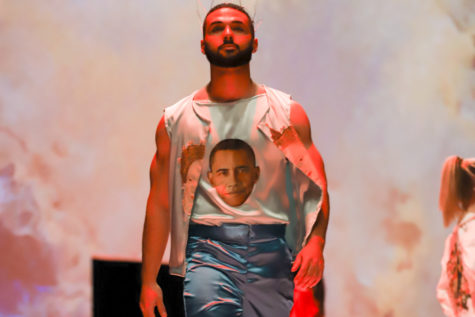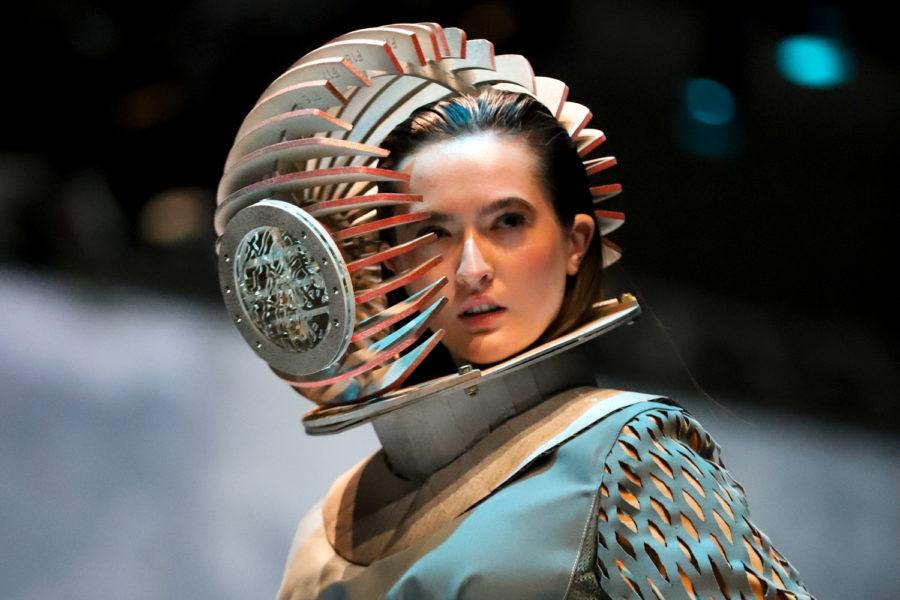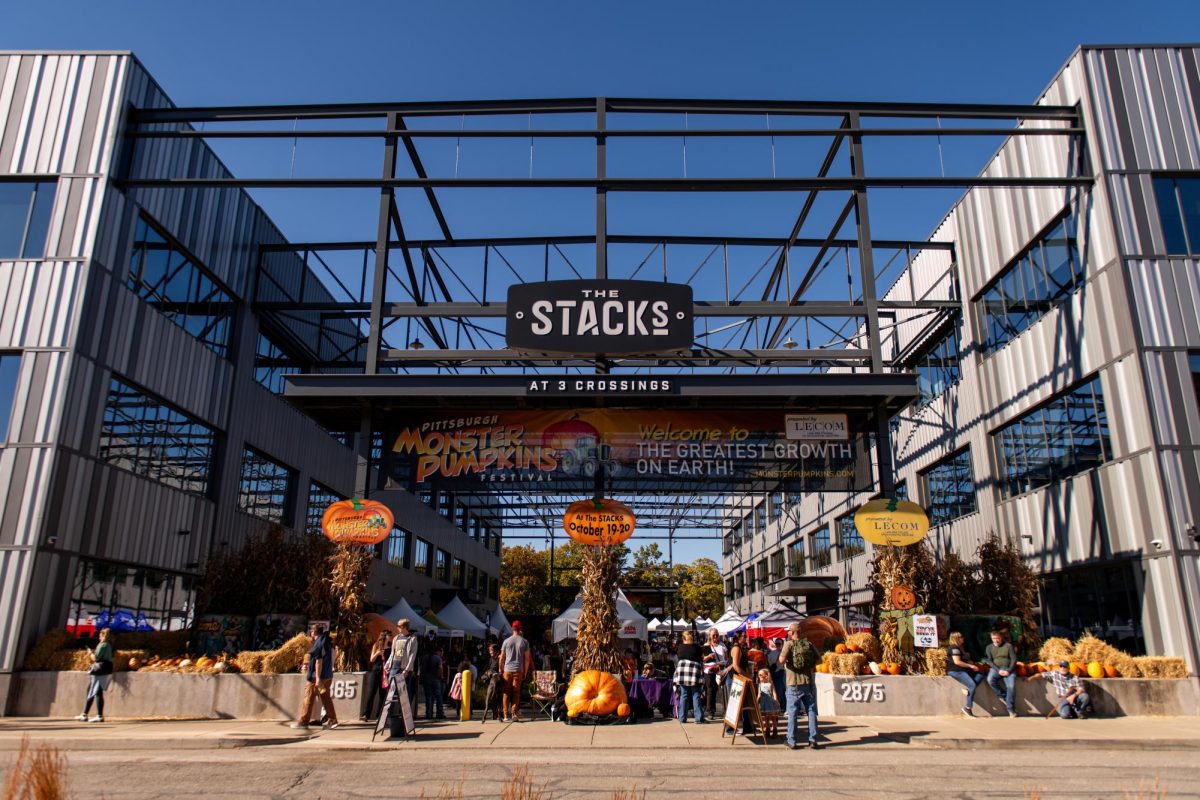CMU Lunar Gala shows off glowing fashion
Kaycee Orwig | Staff Photographer
Saturday evening’s Lunar Gala Fashion Show primarily featured designs from CMU students.
March 5, 2019
After completing their initial walk, models for Carnegie Mellon University’s annual Lunar Gala fashion event waited as the stage became dark, revealing the glow-in-the-dark paint on their garments that highlighted new embellishes on their clothing.
This particular line — titled “Aluminare” — made use of resin, which was provided by Dallas-based company Art ’N Glow. Crowds of about 1,200 gathered on Saturday in CMU’s gym, now transformed into a runway for the 23rd Lunar Gala, one of the largest fashion events in Pittsburgh.
Lunar Gala is a student organization of about 150 students at CMU. However, anyone in the City can participate. The organization consists of students, creative designers, producers, designers and models. It typically sells out around 1,200 tickets, with the proceeds going back into the organization and to the designers through a crowdfunding campaign.
Lunar Gala was founded in 1997 by a group of students who wanted to showcase and celebrate the student body during the Chinese Lunar New Year. Every year the theme has traditionally related to the zodiac symbol for that year. This year was the year of the pig.
The theme of this year’s Lunar Gala, “Anomie,” is a philosophical term that describes a state of society in which there are no morals or bounds for its citizens. Anna Gusman, a senior at CMU majoring in design, explained that the idea stemmed from the current political climate in the past year. The creative team consists of about 16 people from print design, web design, motion design, press release, public relations and photography. As creative director, Gusman’s job is to guide these groups in the direction of a theme or vision.
“This theme fits well for 2018 because if you look at the Pittsburgh fashion and artistic community, you find a lot of people who are trying to create this magical thing out of nothing,” Gusman said. “And we’re all students. We don’t have a lot of money or time, but somehow these people thrive at the intersection of art, technology and music design, and they’re able to create something magical out of that.”
This concept visually translated into the idea of the desert, an arid, dry and apathetic environment.
“We drew influence on the idea of the horizon where the sky meets the ground,” Gusman said. “What is past the vanishing point? Where are we going into the future as we keep trudging together and moving together into this environment?”
Each look featured a different theme and title. The line “Reborn” had a sustainability theme, using discarded fabrics from local designers to bring awareness to the vast amount of waste that is produced by the fashion industry. The garments in “Eden” resembled the visual textures of coral and glacials, addressing mankind’s destruction of the earth through deforestation and oil spills.
The line “Found” made use of recycled materials to produce garments made of recycled newspaper and plastic bags. At the end of the walk, the models held up signs that described where in Pittsburgh the materials were found. The final line, “Boroqué,” was described as “broke, but fancy broke,” taking a pop culture approach to Baroque art with images of Barack Obama beneath Queen Elizabeth printed onto garments.

An outfit from the “Boroqué” line at Saturday evening’s Lunar Gala Fashion Show.
CMU senior architecture major Michael Powell was one of this year’s design coordinators. The design team began the planning process over the summer with recruitment beginning in the fall semester. Every year there are between 40 to 60 applicants, consisting primarily of designers at CMU. About 16 to 18 designers are chosen from the pool of applicants to create garments for the fashion show.
While the design coordinators serve as a support system for designers, providing advice on choosing fabrics and leading sewing tutorials and workshops, Lunar Gala has also built relationships with several local nonprofits and organizations in Pittsburgh over the years. This year they partnered with a Pittsburgh nonprofit called Style412, a collection of local fashion designers in Pittsburgh with varying backgrounds and professional interests.
“Each design team was partnered with a member from Style412,” said Powell. “They were able to act as an adviser or mentor as much as they wanted. So we established a really awesome relationship with them, and I would attribute a lot of our pieces this year to them and their influence.”
Each year CMU alumni or people who have designed in the past for Lunar Gala are also invited to come back and design lines again, in an effort to bring other generations back into the organization.
“This year we invited anyone who did LG in the past — whether they were on creative team, design, production, modeling, whatever it might be, you were invited to design clothes so we made it more open and accessible to our alumni network,” Powell said. “And we also invited alumni models to come back so if the designer and the model wanted to work together again, they were encouraged to do so. I think this year we had two, maybe three alumni models come back, which was super exciting to be able to see those familiar faces again.”
The models in Lunar Gala practice for months in advance, with model casting starting in September of last year, ensuring they establish perfect choreography, timing and establish relationships with their designers. One of this year’s model coordinators Jessica Timczyk — a sophomore technical communications major — used her experience being signed to an agency in New York to help plan the choreography and coordinating the background logistics between the models and designers.
“We try to be as body-diversive as possible,” Timczyk said. “We actually hold auditions right at the beginning of the semester and about 300 people usually audition and we accept about 50. We really just look for someone who knows how to walk already, has confidence and personality. We try to be as inclusive as possible.”
A few months after getting models trained, designers came in and watched the models walk one by one, picking which ones they thought would work best for their lines. After getting chosen for lines, the models began practicing the moves for their designated lines, rehearsing twice a week for two hours each.
“The typical model walk is very straight-back, you have to have super good posture,” Timczyk said. “It’s really about your confidence when you’re walking, too. So just making sure that your arms are swaying lightly and you have a good fierce face on. ‘Smizing,’ like Tyra Banks says.”
The event allowed those involved to reflect on the past year. Gusman, in particular, shared her thoughts on the message of this year’s show and work that went into it.
“2018 was a place of intense debate and political social cultural disparity,” Gusman said. “Kind of the idea that platforms that we currently have to voice our own opinions are the very same thing that distorts them. [We wanted to show] the idea that we’re all trying to communicate and survive, but we can barely see each other or hear each other in the way that we want to be represented or shown.”



